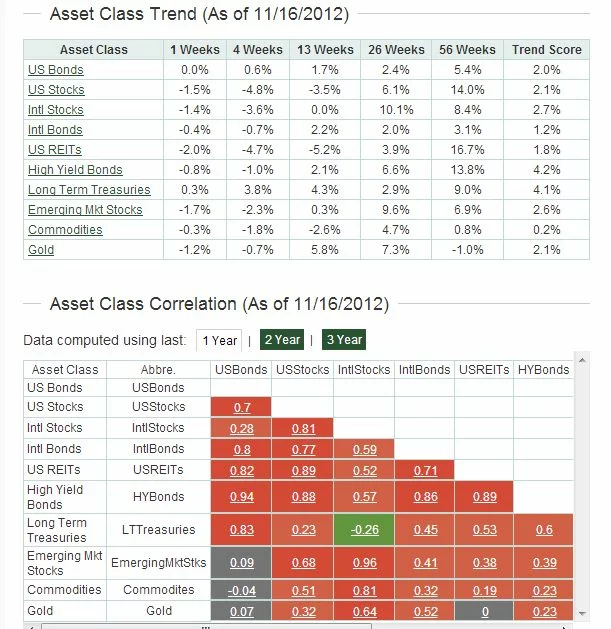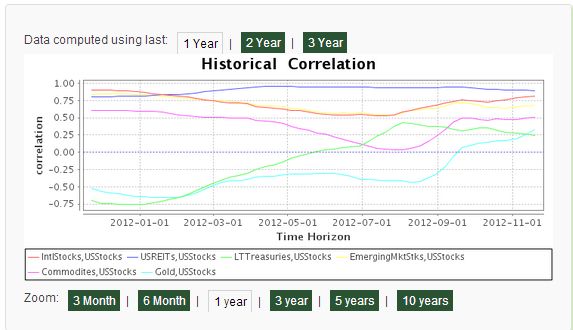Re-balance Cycle Reminder
We just had monthly re-balance today November 19, 2012..The next re-balance time will be on next Monday, December 24, 2012. You can also find the re-balance calendar of 2012 on ‘Dashboard‘ page once you log in.
As a reminder to expert users: advanced portfolios are still re-balanced based on their original re-balance schedules and they are not the same as those used in Strategic and Tactical Asset Allocation (SAA and TAA) portfolios of a plan.
Also please note that we now list the next re-balance date on every portfolio page.
Asset Trends & Correlations
We are releasing a set of new pages this week that monitor asset class trends and their correlations. These pages will serve as references for our users to keep a tab on the most important two factors in asset allocation: asset class return trends and their correlation. Here is the preview of the page.
It is timely to discuss asset trends and their correlations, especially given recent market volatilities.
Current Asset Trends
The following table shows the latest major asset class trend scores (after today (11/19/2012)’s big stock rally):
| Asset Class | 1 Weeks | 4 Weeks | 13 Weeks | 26 Weeks | 56 Weeks | Trend Score |
|---|---|---|---|---|---|---|
| US Bonds | -0.2% | 0.6% | 1.5% | 2.4% | 5.1% | 1.9% |
| US Stocks | -1.5% | -4.8% | -3.5% | 6.1% | 14.0% | 2.1% |
| Intl Stocks | 0.5% | -2.4% | 2.0% | 10.3% | 13.3% | 4.7% |
| Intl Bonds | -0.3% | -0.4% | 2.1% | 2.1% | 3.4% | 1.4% |
| US REITs | -0.5% | -2.9% | -3.6% | 3.1% | 21.6% | 3.5% |
| High Yield Bonds | -0.7% | -0.6% | 2.3% | 7.4% | 14.4% | 4.6% |
| Long Term Treasuries | -0.2% | 3.8% | 3.6% | 2.6% | 7.8% | 3.5% |
| Emerging Mkt Stocks | -1.7% | -2.3% | 0.3% | 9.6% | 6.9% | 2.6% |
| Commodities | 2.0% | 0.6% | -1.2% | 5.3% | 3.5% | 2.0% |
| Gold | 0.3% | 0.2% | 6.7% | 8.5% | 2.7% | 3.7% |
For other asset trend scores, please refer to 360° Market Overview.
Asset Correlations
The following chart shows the historical correlations between U.S. stocks and a few other key asset classes:
The above chart shows the increasingly correlated assets: since June this year, Gold has had a positive correlation with U.S. stocks. Even long term Treasuries has become positively correlated with stocks since this October. However, in the stock market gyrations last week , both gold and long term bonds again showed some negative or non correlation with stocks.
From the correlation table, one can also appreciate why concepts like Permanent Portfolios and Four Pillar Based Portfolios can have appeals: all of the key assets in those portfolios have reasonable long term expected returns while they are less correlated with each other.
Current markets have shown a similar (though not identical) pattern to that in 2008: long term Treasury bonds started to show resilient strength. Gold first experienced some weakness. However, nobody knows for sure whether this will be a 2008-2009 replay. Again, what is important is to stay the course and execute a well defined plan.
Two Key Factors For Portfolio Risk Management
Diversification:
Many claim that the concept of diversification is broken: in a market crisis, all (risk) assets are positively correlated and thus drop together. We believe this statement presents only half truth: in short term, many assets can all behave similarly, however, in a long period, they do tend to diverge. A diversified portfolio thus has a higher probability to get less damaged.
Furthermore, even amid increasingly correlated markets, some assets such as long term bonds still show negative correlations with stocks and other risk assets such as high yield bonds and commodities. These assets serve as hedges in a crisis. The best examples here are David Swensen Six ETF Asset Individual Investor Plan and Harry Browne Permanent Portfolio.
To cope with short term volatility, another factor is the proper risk level setting:
Risk Profile:
We have emphasized many times that setting a right risk profile for a portfolio is paramount to investment success. See, for example, March 12, 2012: Setting The Right Risk Profile. The importance here is that a right risk profile gives your portfolio an acceptable risk level by allocating at least portion of capital in ‘safe’ bonds. Though we all know that current interest rate is extremely low and bonds are as riskier as stocks in the coming years, their correlation with stocks and other risk assets provides a cushion in a market disaster.
We should note that there are still several ways to invest ‘more safely’ in bonds: first, in a rising rate environment, the least one can do is to move to short term investments such as cash, floating rate bank notes and short term bonds. Moreover, international bonds and high yield bonds can also provide some short term opportunities even in a deteriorating fixed income environment. See, for example, October 22, 2012: Income And Conservative Portfolio Review.
To summarize, asset trends and their correlations can serve as good indicators for short and long term major asset behaviors. They are useful references and can be also important educational materials to help reinforce diversification and risk management concepts.
Market Overview
As shown in the above major asset trend table and that on 360° Market Overview, both international REITs and international stocks are now ranked on the top spots, in addition to emerging market bonds. After last week’s major weakness of U.S. stocks, the major assets are showing somewhat strange trend rankings: the weak European stocks are now better ranked than their U.S. counter parts. This can be explained by the uncertain outcome of the Fiscal Cliff facing many U.S. companies and in general, the U.S. economy. However, globally, we see both weakness or green shoots. For now, another period of delayed resolution might be the outcome. But we remain deeply skeptical on this rally.
We again copy our position statements (from previous newsletters):
Our position has not changed: We still maintain our cautious attitude to the recent stock market strength. Again, we have not seen any meaningful or substantial structural change in the U.S., European and emerging market economies. However, we will let markets sort this out and will try to take advantage over its irrational behavior if it is possible.
We again would like to stress for any new investor and new money, the best way to step into this kind of markets is through dollar cost average (DCA), i.e. invest and/or follow a model portfolio in several phases (such as 2 or 3 months) instead of the whole sum at one shot.
Latest Articles
- Total Return Bond Funds Excel In The Troubling Markets
- Do a portfolio risk profile to prepare for fiscal cliff
- The End of a Trend?
- Two Measures of Inflation: New Update
- Investment Process Is The Only Way To Cope With Uncertainties
- Game Theory, Behavioral Finance, and Investing: Part 3 of 5
- The Fiscal Cliff and Stock Market Performance
- Hope for unloved U.S. financial services stocks
- Game Theory, Behavioral Finance, and Investing: Part 2 of 5
- November 12, 2012: Multiple Portfolios As Another Diversification Dimension
How can we improve this newsletter — we value your inputs –Thanks to those who have already contributed — we appreciate it.



 Diversified Asset Allocation Portfolios For Your Plans
Diversified Asset Allocation Portfolios For Your Plans
